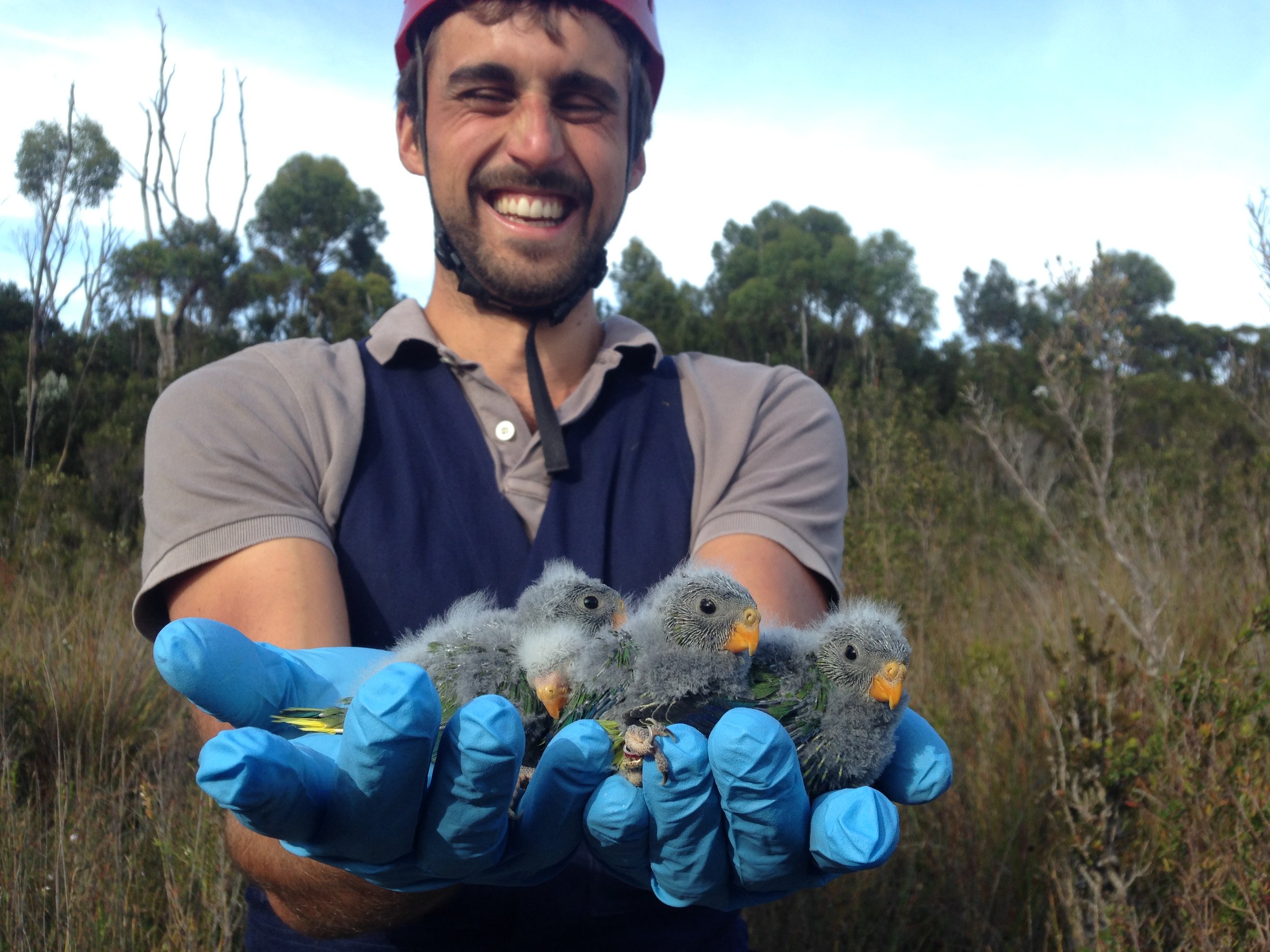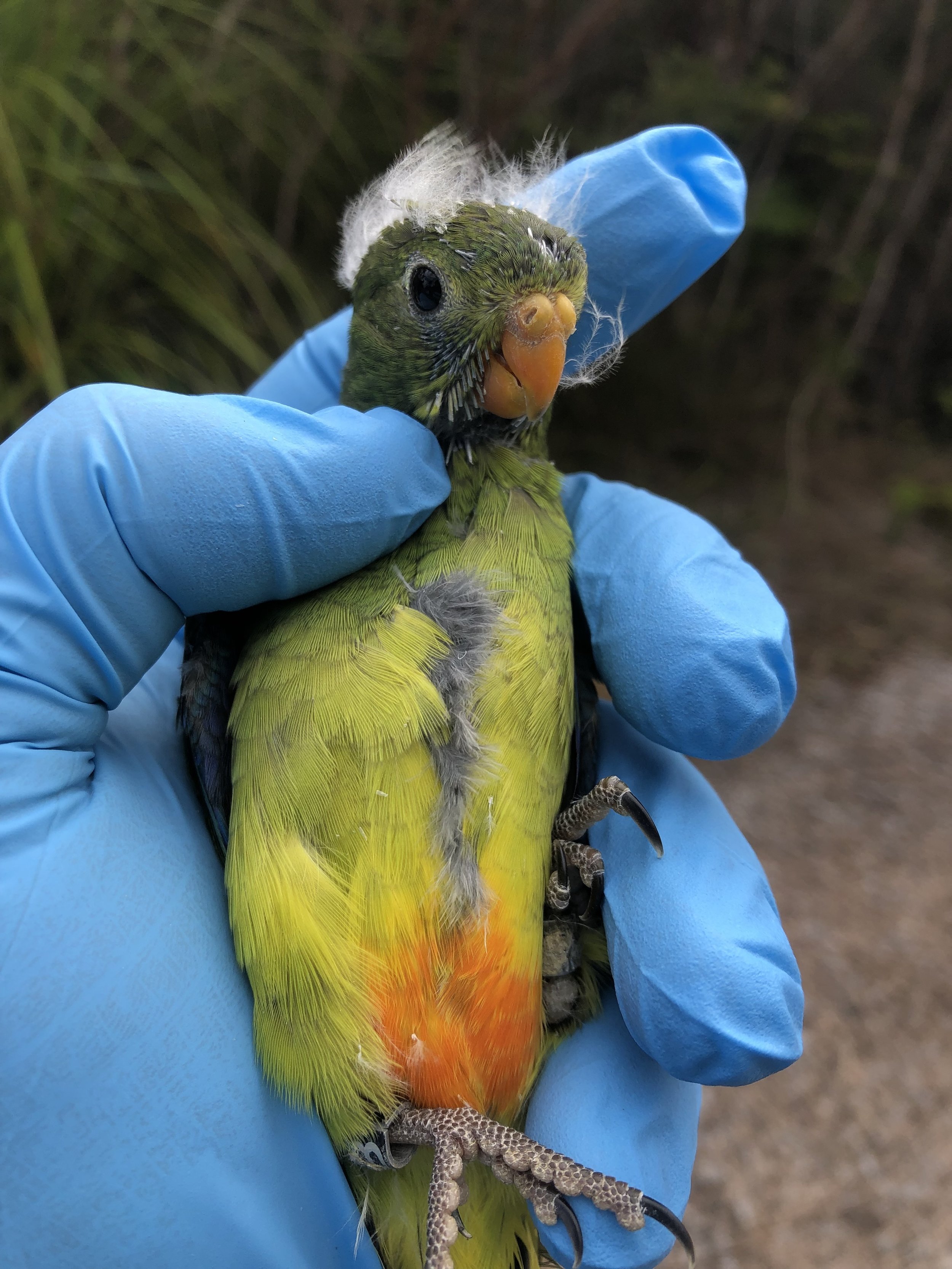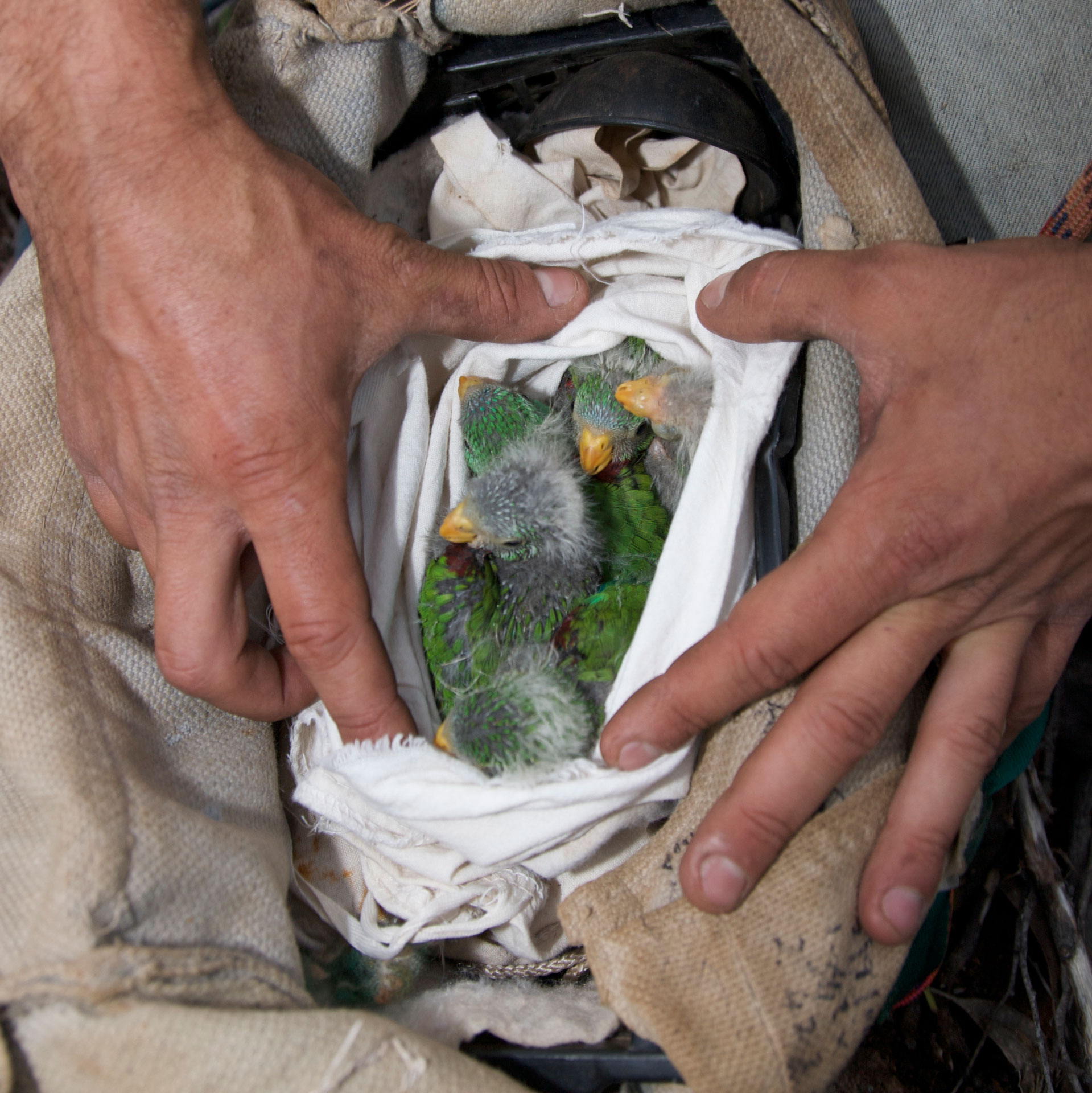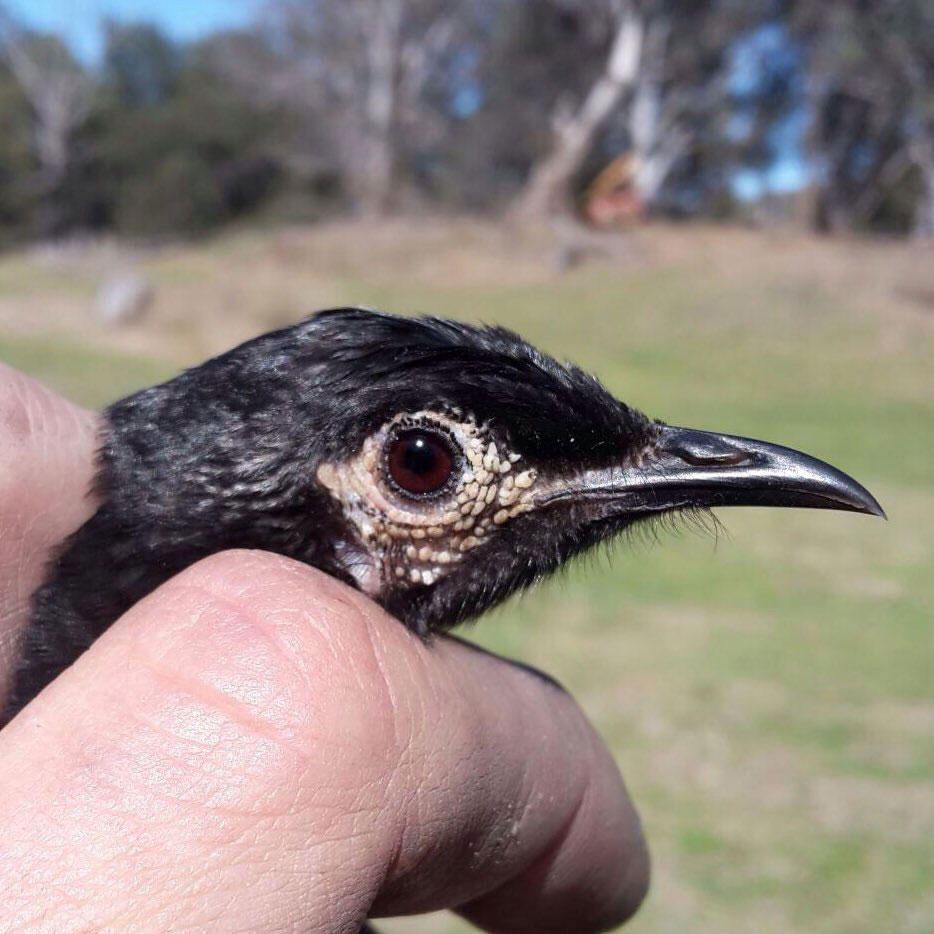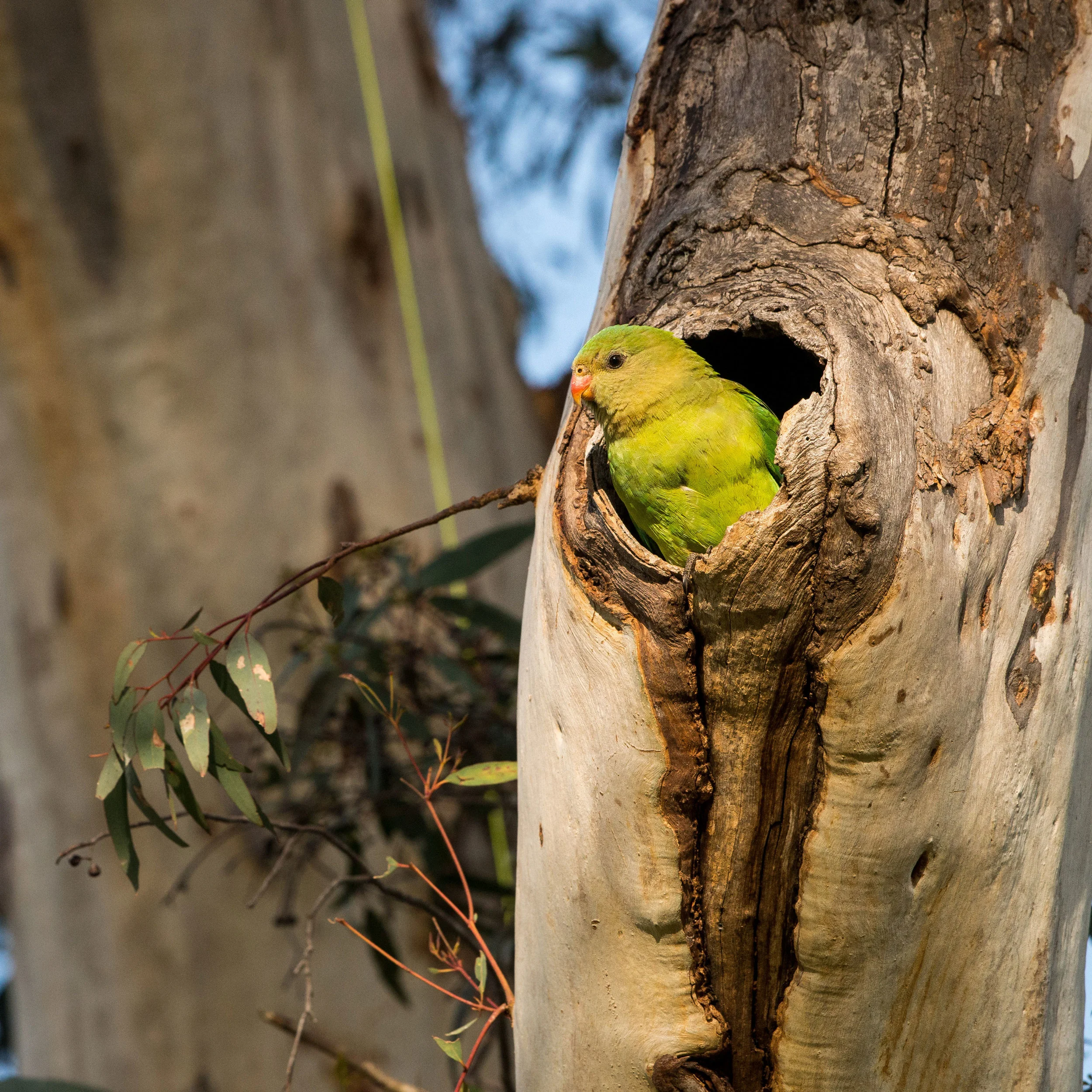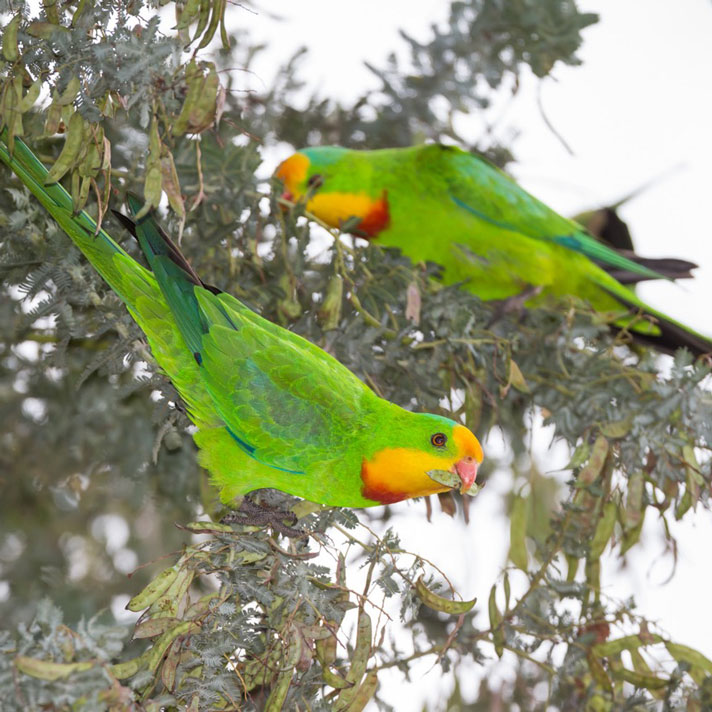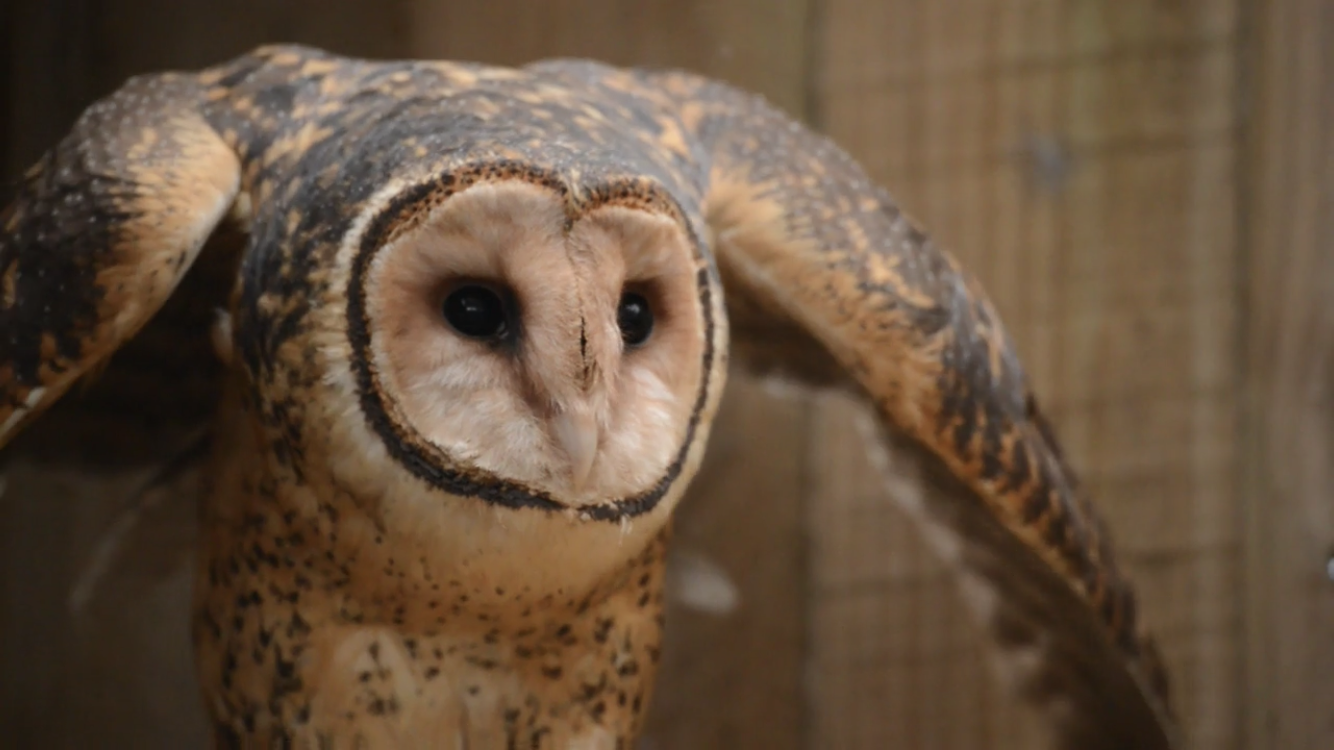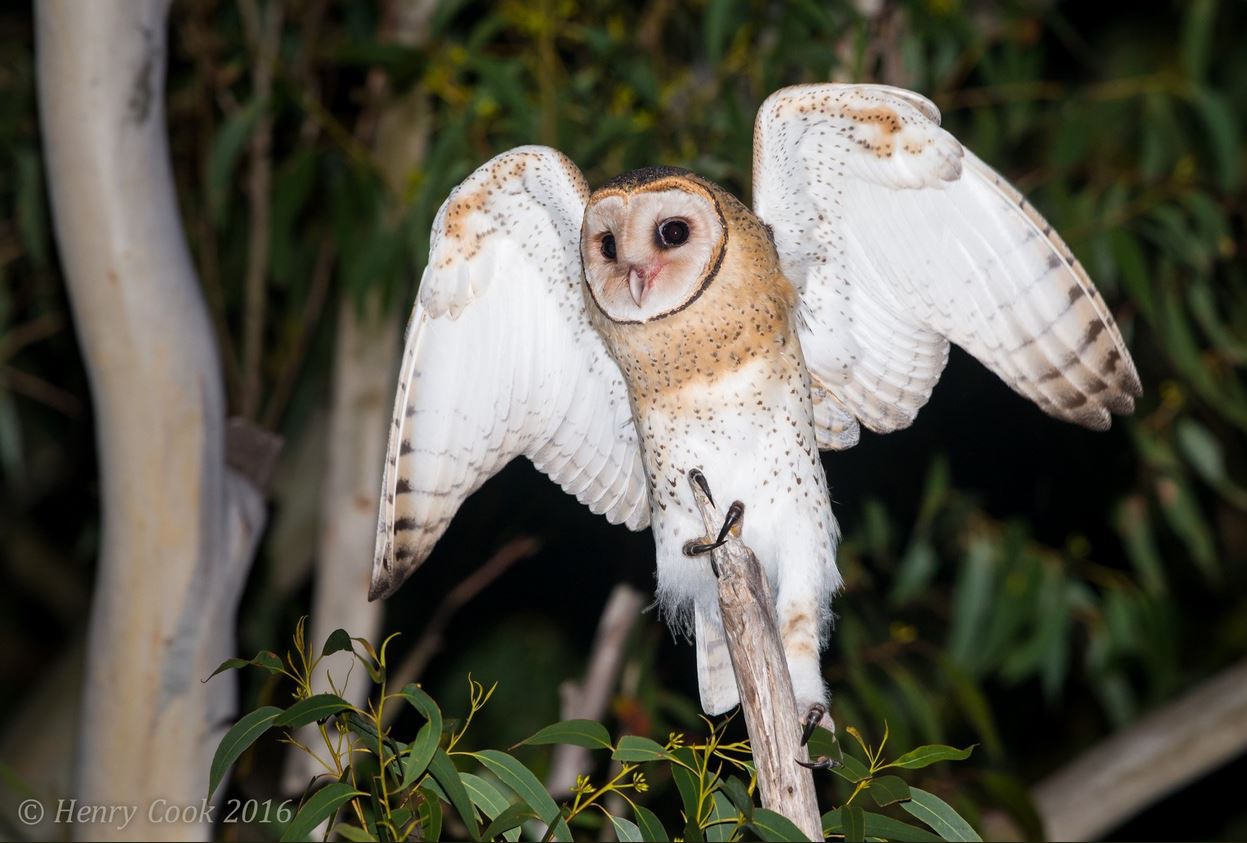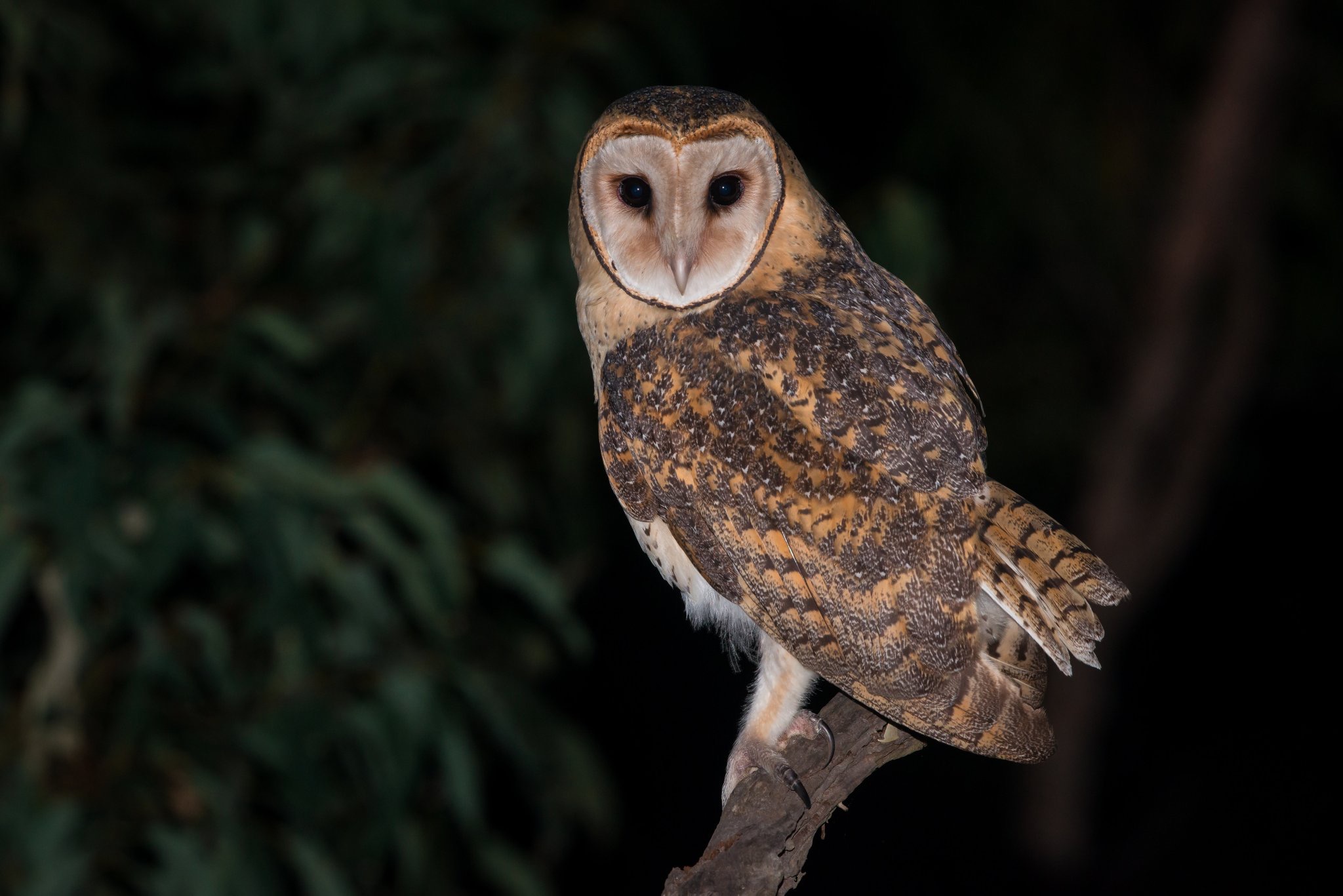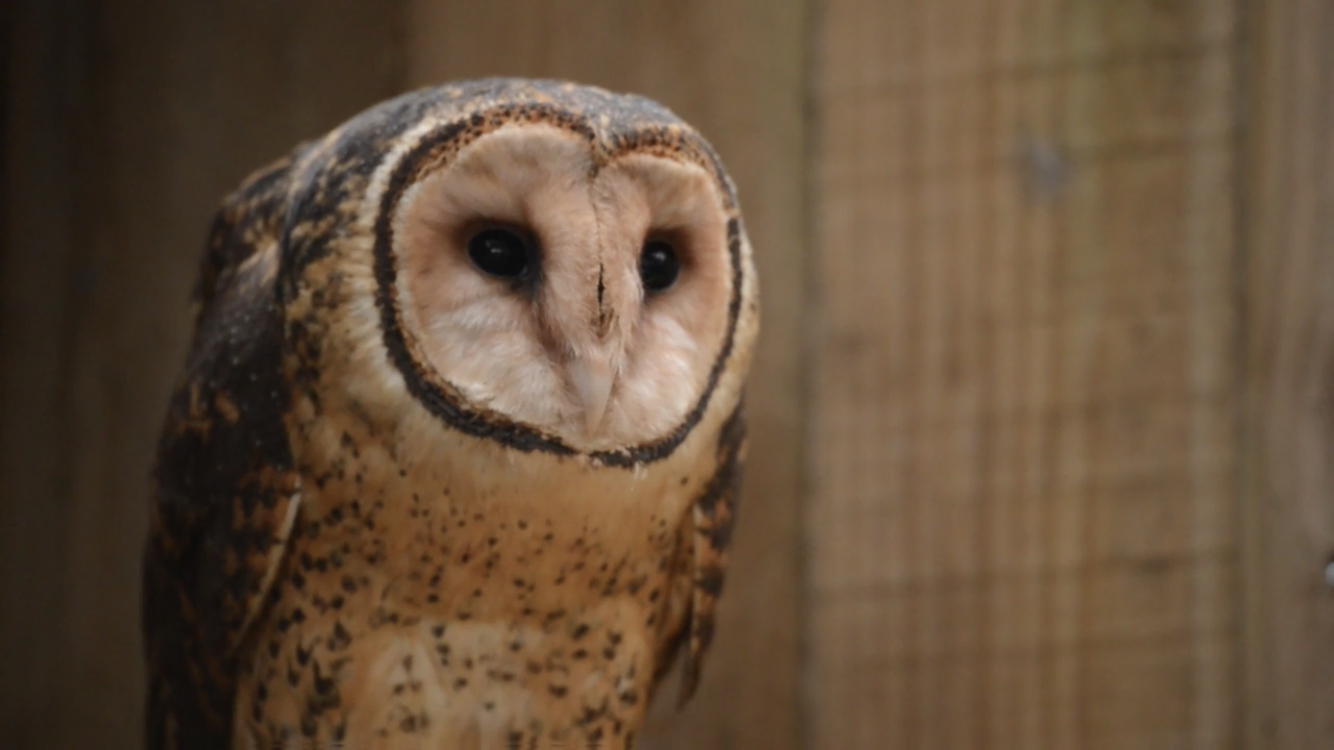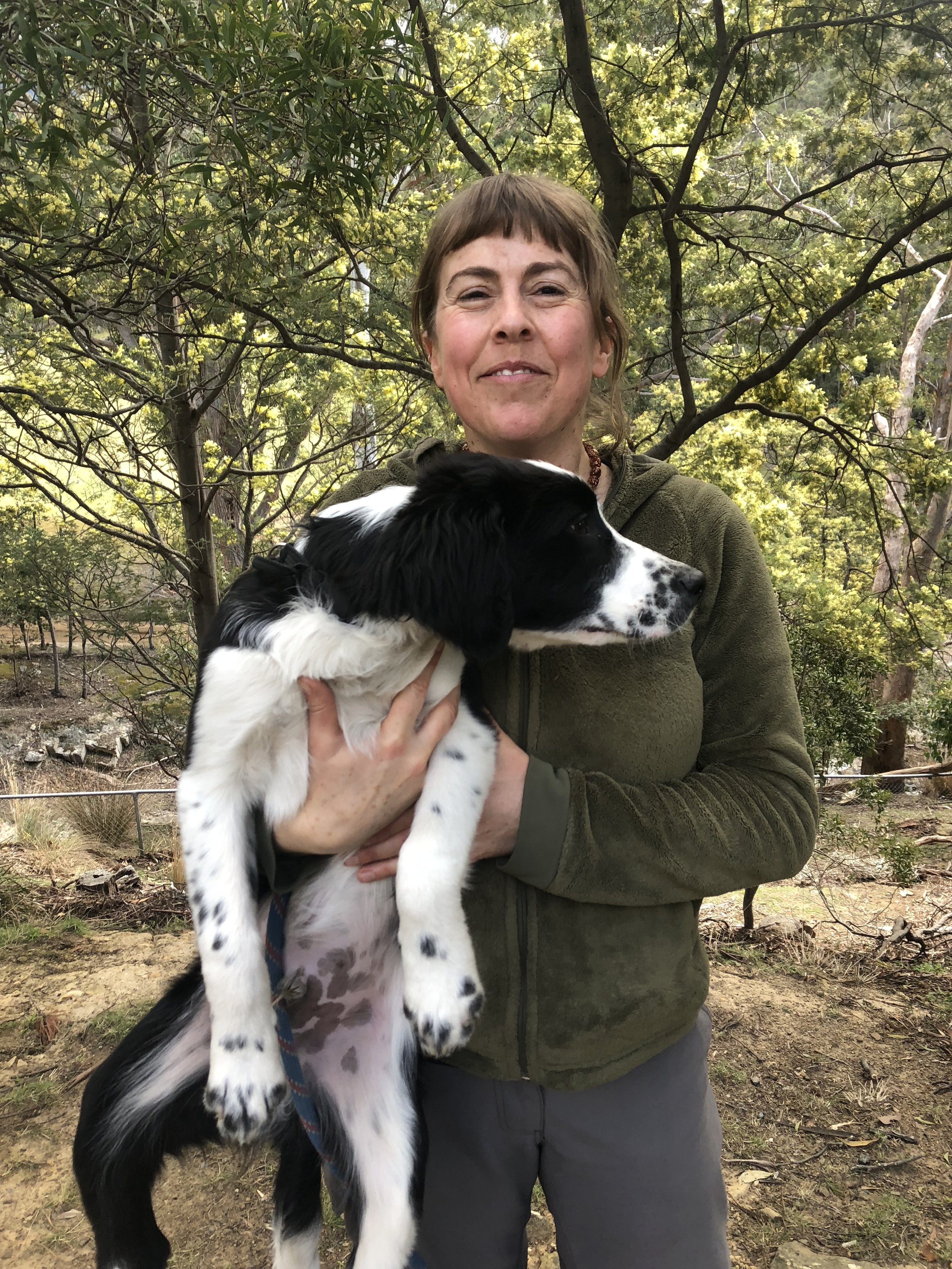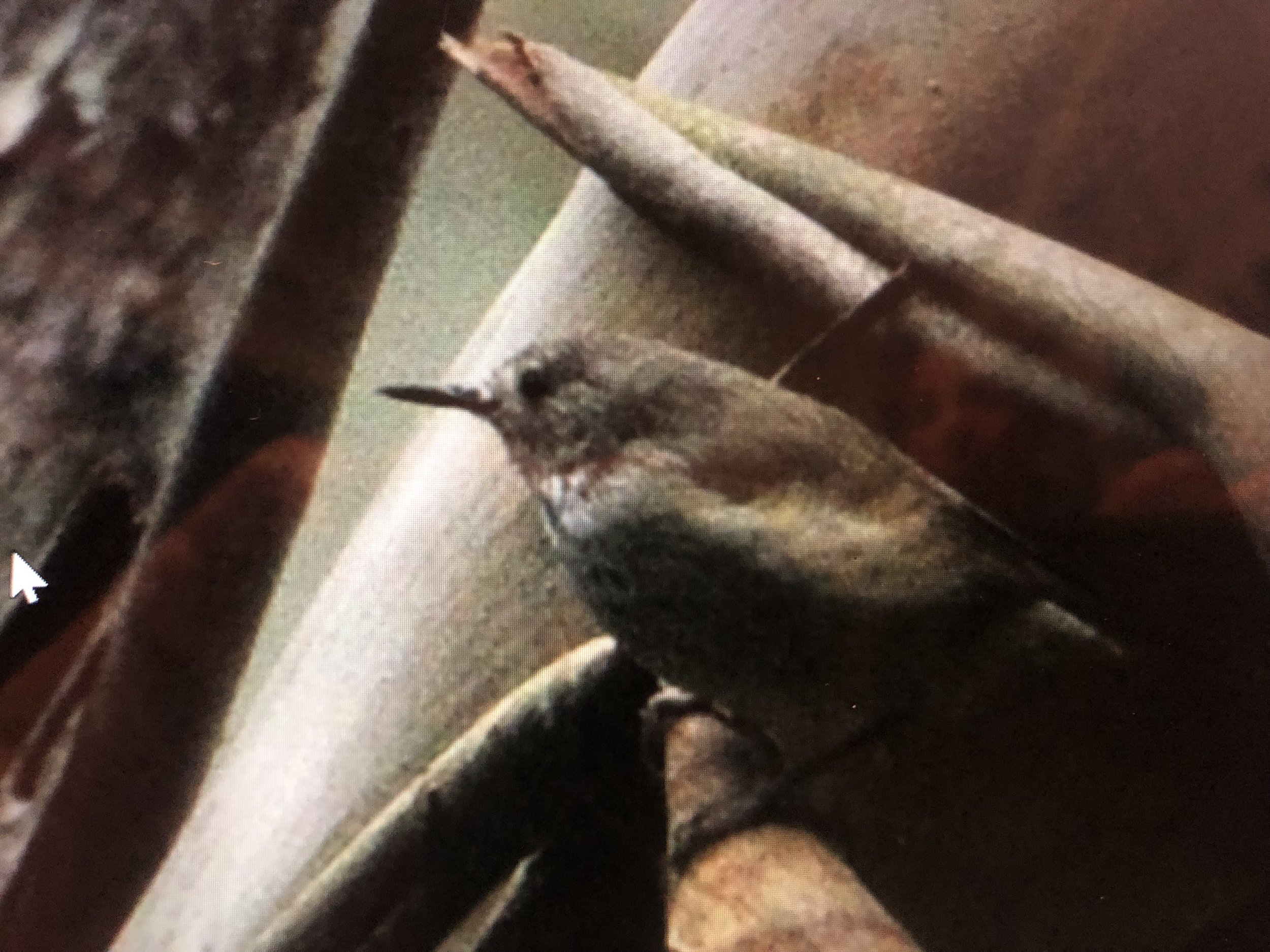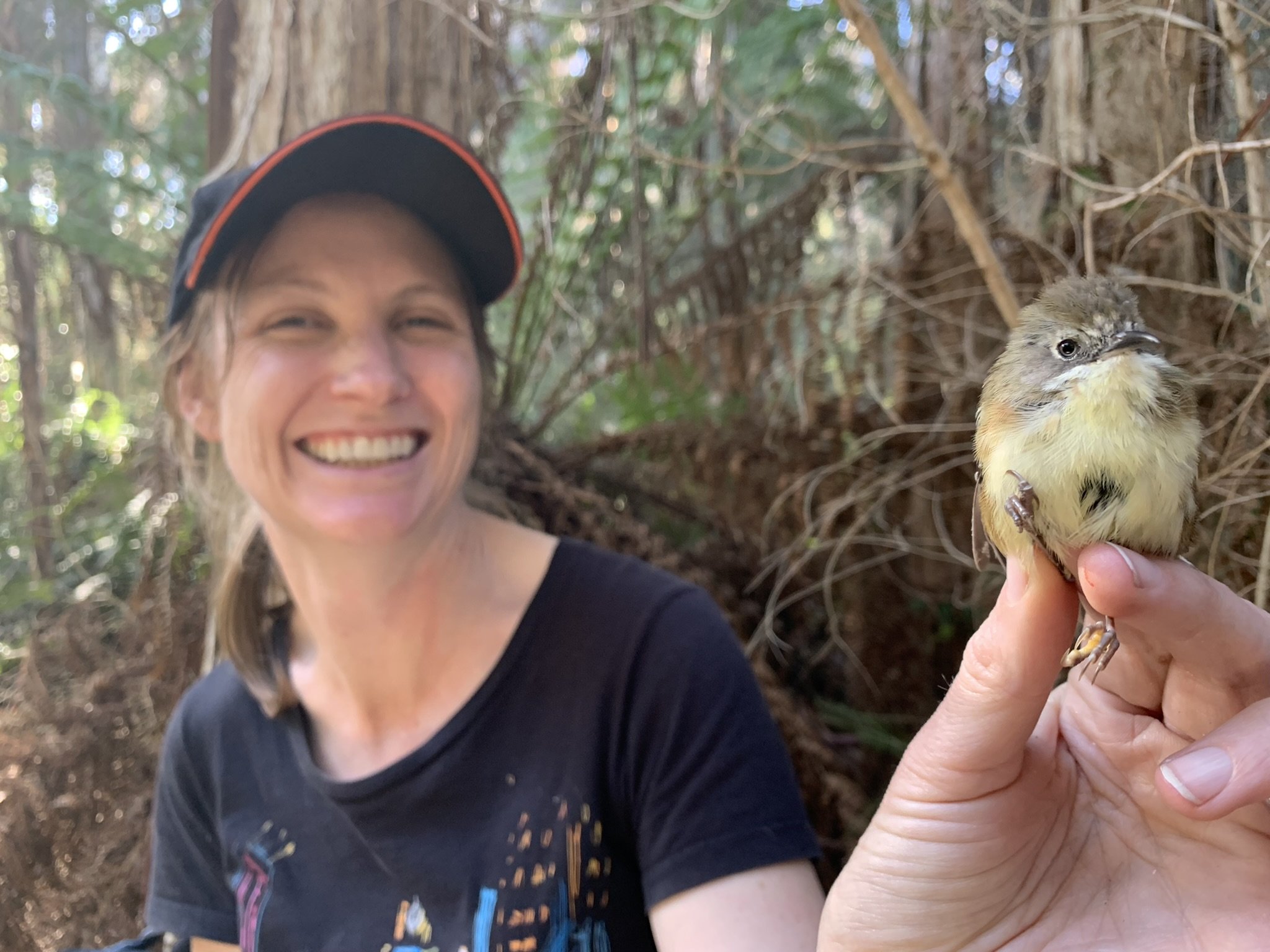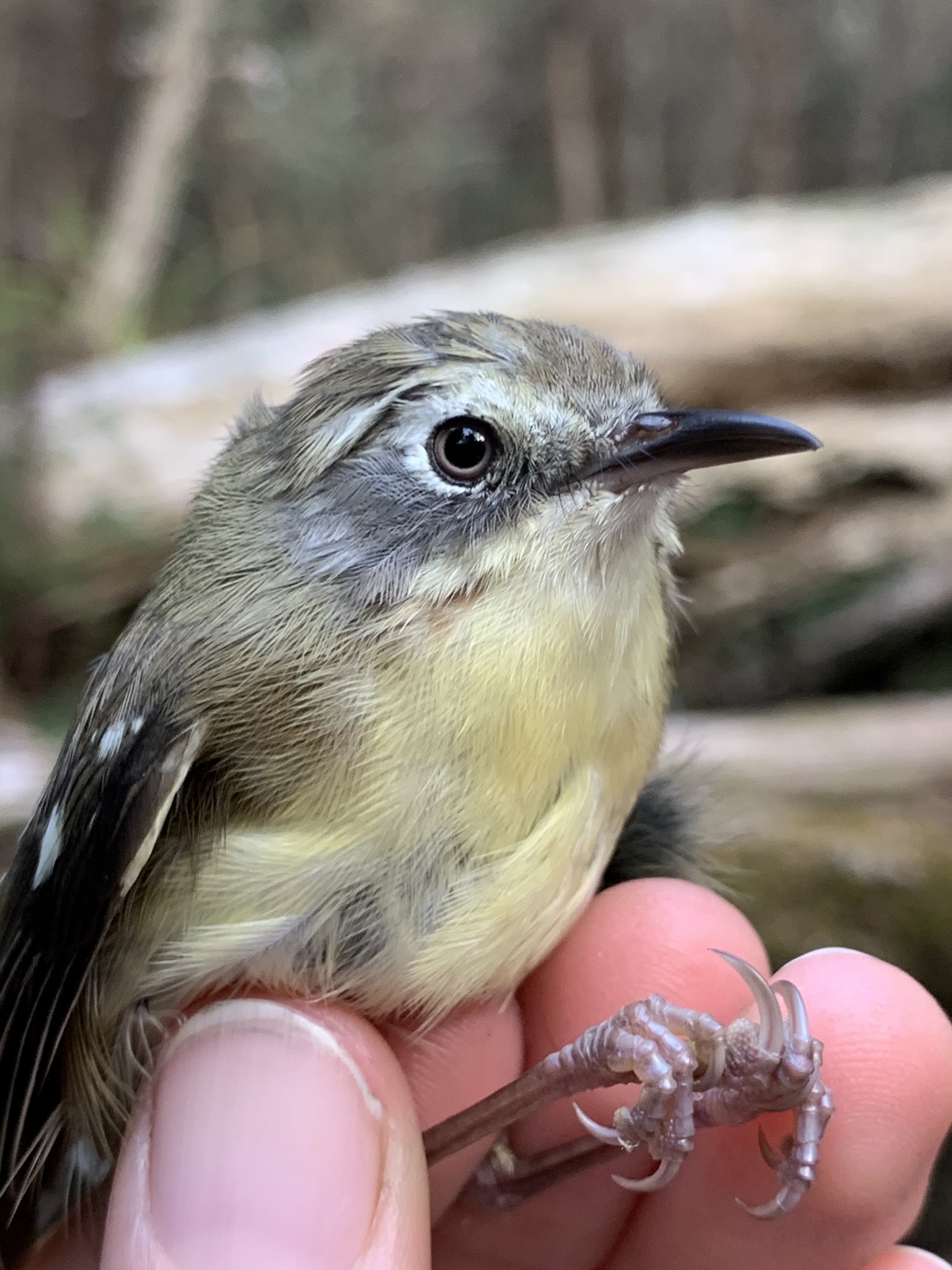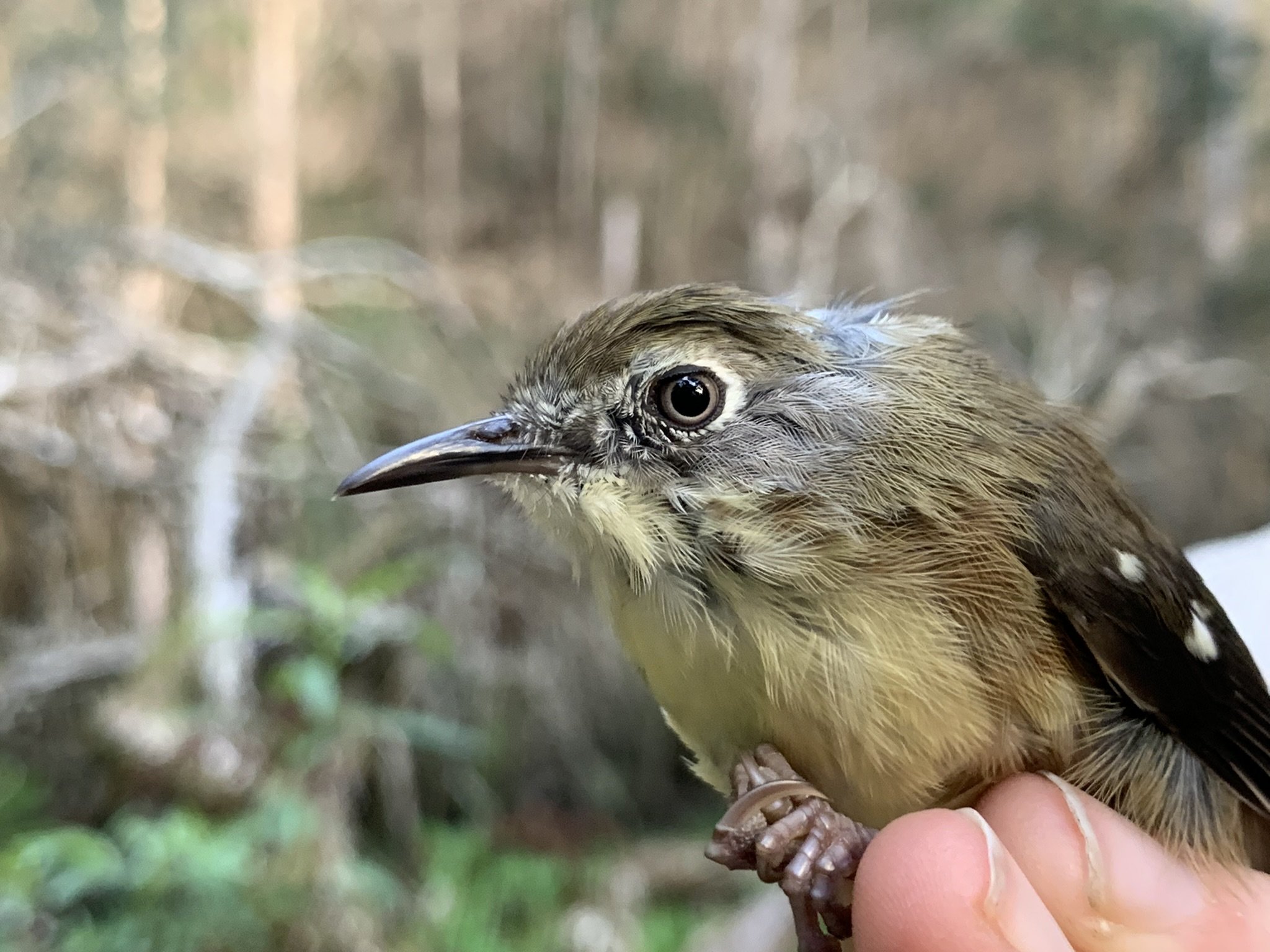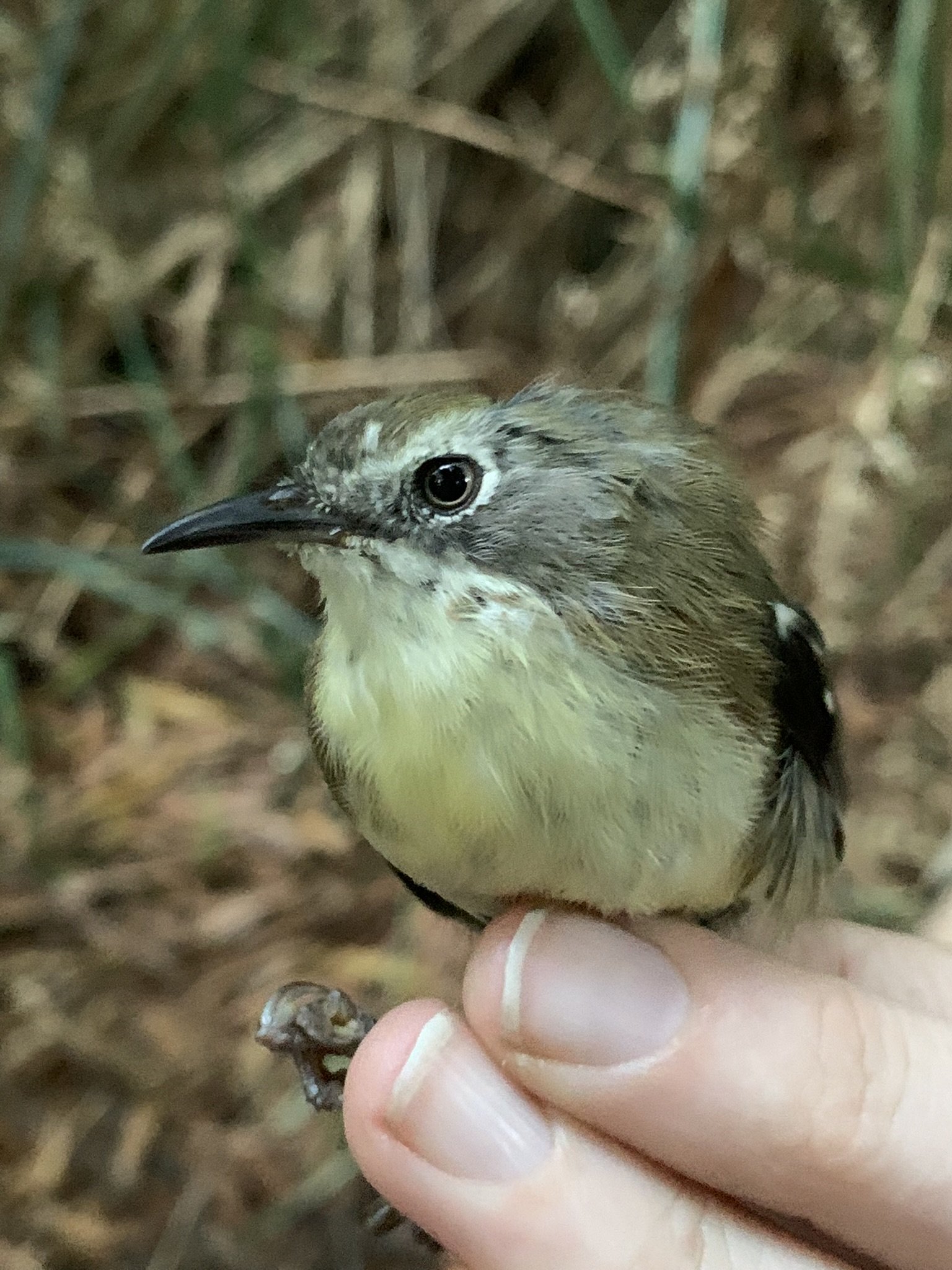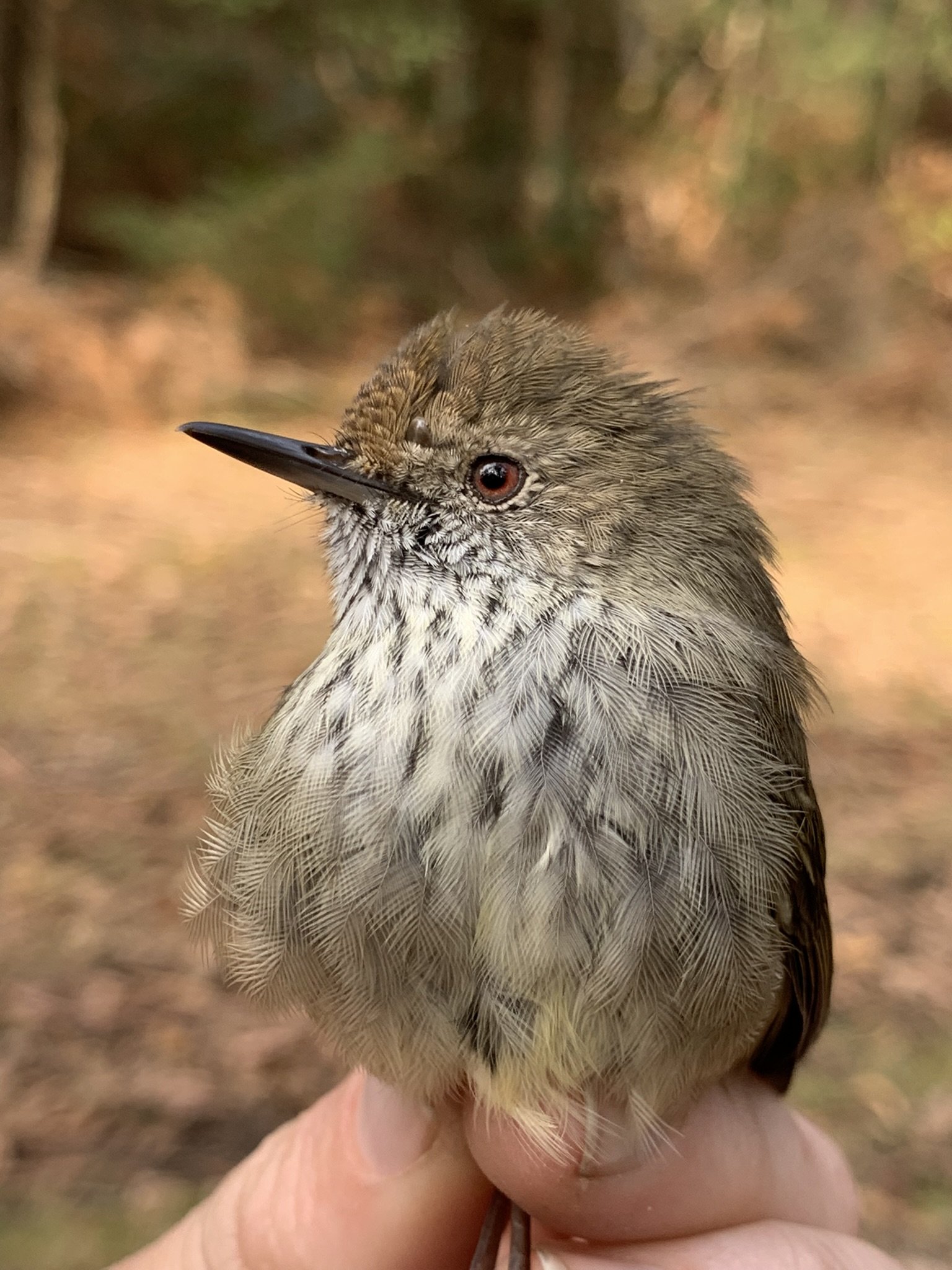







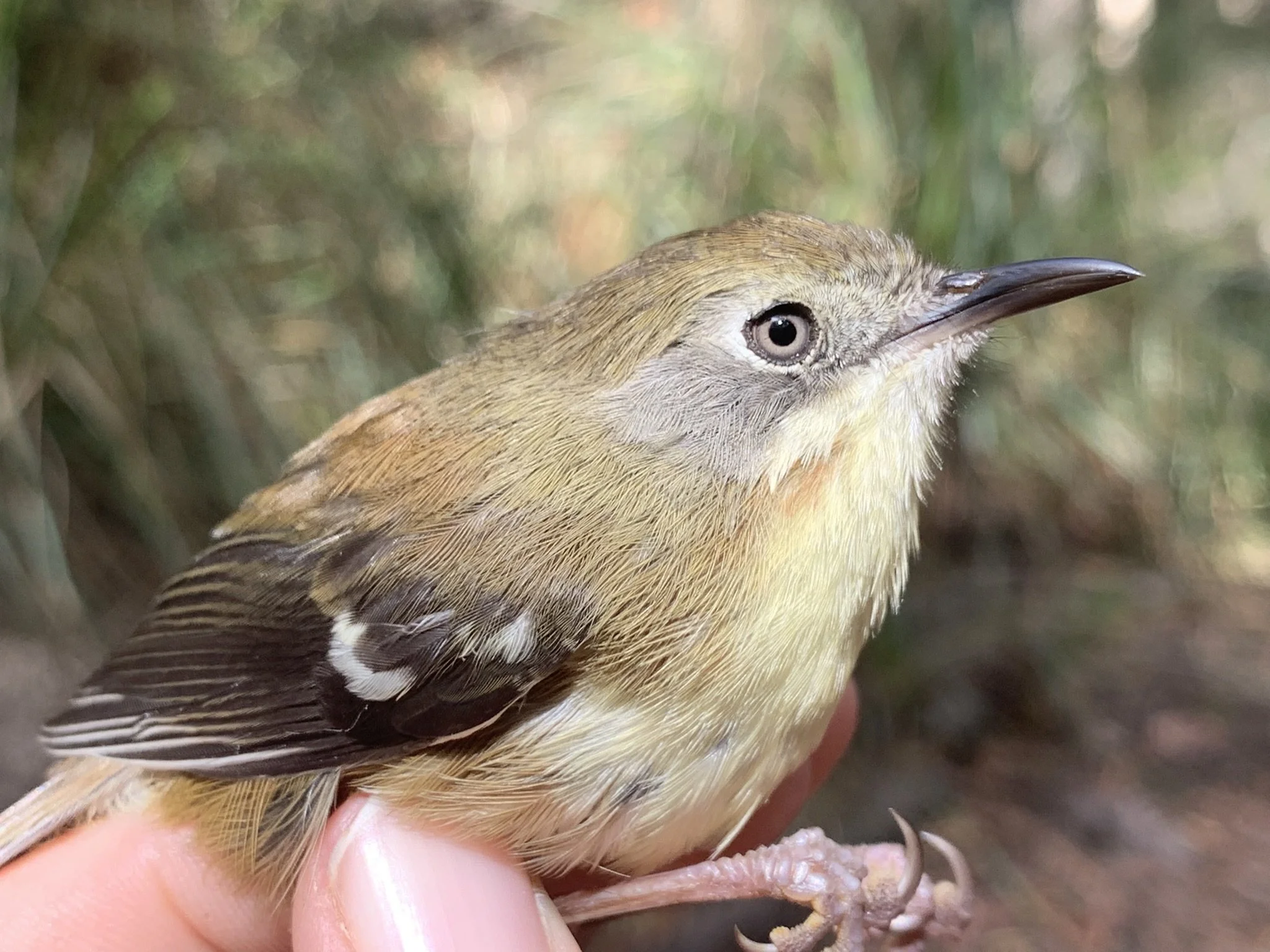

Study Species
Study Species
Study Species
Study Species
Difficult Bird Research Group runs the national monitoring programs for the swift parrot, regent honeyeater, forty spotted pardalote, superb parrot and the palm cockatoo, and we are leading an urgent intervention to rescue to orange bellied parrot from extinction.

Orange-bellied parrot
Orange-Bellied Parrot
Orange-bellied parrot
Orange-Bellied Parrot
Species
The critically endangered orange-bellied parrots (OBP) is Australia’s most threatened bird. The species is migratory, and breeds in the rugged Tasmanian Southwest World Heritage area before migrating to the southern coastline of mainland Australia for the winter. The species depends on tree cavities for nesting, but these trees must occur near coastal moorland where the herbs and seeds they need for food occur. OBPs use mainland coastal saltmarsh to see out the winter, but such habitats have been dramatically degraded or removed since European settlement. Because the species has been in decline for decades, a captive population was established to act as insurance against extinction. Captive bred birds have been released into the wild for decades, but this has failed to stem the species decline. As at 2016 only 3 wild females and 11 wild males returned to their breeding ground. The Tasmanian Department of Primary Industries, Parks, Water and the Environment (DPIPWE) have monitored OBPs at their last breeding grounds for decades, and we have formed a collaboration with DPIPWE to advance the conservation status of OBPs.
Why it’s difficult
The tiny population size of OBP is the biggest problem it now faces. There is also a lot of uncertainty about the causes of their decline. The last breeding ground of the OBP is Melaleuca, in remote and rugged southwest Tasmania. Although magnificent, this location poses major logistic challenges for work, and makes finding OBPs very difficult. Unfortunately, the release of captive bred birds has not recovered the population of OBPs, meaning that additional approaches need to be implemented urgently. Delay or failure to carry out additional management and research to increase the reproductive output of the remaining population, and improve knowledge of threatening processes, could lead to the extinction of orange-bellied parrots.
What we’re doing
Landscape scale
We are researching the level of risk faced by OBPs in their historic breeding range from predation by sugar gliders. Gliders are known to have eaten breeding OBPs at some of their historic locations, and this may have played a role in their decline. However this information is crucial in long term planning for OBP recovery because establishing a second population is a key aim. Deciding where to locate a second population though will be dependent of where OBPs are likely to be safe from predation by sugar gliders. We are surveying historic location where OBPs are known to have bred to identify whether sugar gliders are present/absent at a site, and to evaluate the suitability of historic sites as places to establish another insurance population.
Fine scale
Using approaches developed and implemented successfully for other species, we use intensive, individual based approaches to intervene in the nest productivity of wild OBPs. We aim to increase the number of wild bred individuals produced. We:
egg swaps (replace infertile wild eggs with fertile eggs from captivity)
clutch supplementation (add fertile eggs from captive birds to wild nests)
brood supplementation (add/swap nestlings among nests to ensure sibling competition doesn’t disadvantage the smallest neslings)
emergency interventions (remove and artificially incubate abandoned eggs, supplement food to struggling nestlings, remove abandoned or ill nestlings for temporary hand-rearing, supplement food to nests with inflated broods)
monitor nests with video cameras mounted inside nest boxes
quantify and manage the impacts of nest box competition with tree martins
evaluate the impact of ecological burning on local habitat quality at Melaleuca to estimate change in the abundance of natural food
revisit, analyse and publish existing data collected by DPIPWE to draw new lessons about how to better manage OBPs and other endangered species

Swift Parrot
Swift Parrot
Swift Parrot
Swift Parrot
Species
Swift Parrots are a critically endangered nomadic migratory bird found only in south-eastern Australia. Their small population of less than 2000 birds is continuing to decline largely due to loss of habitat in both their breeding range (eastern Tasmania) and non-breeding range in south-eastern mainland Australia. A newly identified threatening process, predation by introduced sugar gliders in Tasmania, is also a major driver of their continued demise. Sugar gliders kill and eat adult female swift parrots while they are incubating their eggs, as well as the eggs and nestlings. Up to half of the nesting parrots can be eaten by sugar gliders every year. Swift parrots require two distinct but related habitat features to breed (1) food from flowering trees and (2) tree hollows for nesting. If these resources don’t overlap in space and time, breeding cannot occur. In their wintering range, swift parrots undertake long distance nomadic movements to find food.
Why it’s difficult
Swift parrots depend on suitable conditions across multiple, distant locations throughout their migratory cycle. Managing the species poses substantial challenges because of the great plasticity in their annual movements in response to highly variable climatic conditions, their drastically reduced numbers and their dependence on habitats in modified landscapes. Swift parrots also nest in extremely remote and rugged terrain in Tasmania, nesting in treetops of old growth forest.
What we’re doing
Landscape scale
We established a population monitoring program in 2009 through collaboration between the project team, the Swift Parrot Recovery Team, the Commonwealth and Tasmanian Governments and BirdLife Australia which addresses key actions of the swift parrot Recovery Plan. The monitoring program surveys >1000 sites in potential foraging habitat across the breeding range to track annual variations in the distribution and relative abundance of the swift parrot population and provides a measure of available breeding habitat as defined by tree flowering. Results from this landscape scale monitoring are then used to guide a survey of nesting habitat to assess the spatial distribution and density of breeding birds and factors affecting nest site selection. These data have allowed us to track trends in swift parrot site occupancy and abundance over several years, investigate habitat use and to identify priority areas of habitat. These data are crucial for understanding how the birds respond to patchy and unpredictable tree flowering events by shifting the locations where they breed.
We also are working on the Australian mainland where swift parrots spend the winter. In collaboration with the NSW Government we are undertaking a project that focuses on the western slopes in the Riverina and drought refuge habitat on the Central Coast. This work represents the most extensive winter habitat restoration project ever undertaken, and will build on long term knowledge about the species winter habitat use. We are also investigating changing use of habitats over the past 20 years on the Australian mainland by swift parrots, as well as the implications for land management in relation to changing climate.
Fine scale
Using our landscape scale monitoring data, we identify where swift parrot nesting aggregations occur each year across Tasmania. Swift Parrot breeding sites vary annually over a large range of fragmented habitat in south-eastern Tasmania, with the exact location of breeding each year depending on the intensity of local blue or black gum flowering and the availability of tree hollows for nesting. We are leading the first study to identify determinants of their breeding site choice and reproductive success against the backdrop of the annual variations in the distribution and availability of breeding habitat which has been dramatically altered and fragmented since European settlement, and the increased mortality rates due to predation by introduced sugar gliders. Our research has shown that nomadic movements within Tasmania to the best available flowering conditions to breed successfully, but that the effect of sugar gliders on their populations can be very severe in some places. We are also undertaking ground breaking research using high tech GPS loggers and motion activated cameras to identify where breeding swift parrots search for food while nesting and to identify the causes of nesting failure.
ANNUAL SETTLEMENT PATTERNS OF SWIFT PARROTS ACROSS THEIR BREEDING RANGE

Regent Honeyeater
Regent Honeyeater
Regent Honeyeater
Regent Honeyeater
THE SPECIES
The regent honeyeater is Australia’s most threatened songbird. Once common throughout the south-east (including suburban Sydney and Melbourne), the population has crashed since the 1960’s due to extensive land clearing. It is now on the verge of extinction, listed as critically endangered under national and international legislation. Best available data suggest that fewer than 400 individuals remain and population decline is ongoing.
Regent honeyeaters exploit flowering events to feed on a select number of Eucalyptus species, with a strong preference for highly threatened Yellow box Eucalytpus melliodora and Mugga Ironbark Eucalyptus sideroxylon. Current knowledge suggests their movement and settlement patterns reflect high spatiotemporal variability in the timing and intensity of flowering events in their preferred food trees. The birds nest during the Austral spring/summer and can form small breeding aggregations where habitat conditions are suitable. They are territorial and aggressively defend their nesting area.
WHY IT’S DIFFICULT
Regent honeyeaters are highly mobile and extremely elusive. With its small population size (<400) and massive range (>600,000 km2) finding this species, let alone studying it, presents a world of challenges. There are very few places where the bird can be reliably detected between and within years. This has severely limited attempts to understand why the regent honeyeater has declined so severely and rapidly, particularly among other co-occurring nectarivore species that persist at high abundances in similar environments.
WHAT WE’RE DOING
We are currently undertaking national-scale monitoring throughout the species’ range, in order to substantially improve our knowledge of the regent honeyeater’s habitat requirements, nesting success rates and causes of nesting failure, as well as their movement patterns and social ecology. Our primary project aims are:
1) Collect ecological evidence to enhance and direct current and future conservation actions (such as habitat restoration, land protection and captive release) for regent honeyeaters;
2) Track the flower and nectar phenology of dominant Eucalyptus feed trees across the species’ range to improve our understanding of regent honeyeater movement, habitat selection, competition and social dynamics;
3) Devise innovative ways to prevent the extinction of wild regent honeyeaters that explicitly account for the species’ unusual ecological attributes and requirements;
4) Undertake cutting-edge genetic analyses to understand and manage the impacts of rapid population decline on the genetic make-up of the regent honeyeater population;
5) Determine how the population decline could affect the song repertoire of the regent honeyeater, particularly individual males.
National scale
Despite it’s iconic status and the urgent need for conservation advice, no standardised range-wide monitoring protocol exists for the regent honeyeater. To date, our entire understanding of population size and trajectory is drawn from haphazard landscape-scale surveys and, crucially, incidental sightings from members of the concerned public.
Strategic and standardised monitoring of the regent honeyeater population across its full extent of occurrence is vital for (i) deriving robust population estimates, (ii) identifying critical breeding and foraging habitat, and (iii) directing effective conservation action. Importantly, a holistic national-scale approach to monitoring allows for comparisons between and among known breeding landscapes, across space and through time. Such information is currently unavailable, but will be essential for (i) understanding interactive and emerging threats to the species’ survival, (ii) tracking variation in the abundance and availability of critical foraging and nesting resources, and (iii) forecasting the impacts of climate change on regent honeyeater distributions and population persistence.
Further to a holistic approach, monitoring for this rare and highly mobile bird must be targeted. A monitoring program tailored specifically to the species’ ecology is crucial for maximising return (i.e. sightings) on investment (i.e. search effort). With fewer than 400 birds spread across an area the size of France, strategic site placement is key. In turn, we have gone to massive efforts to gather the most up-to-date knowledge on regent honeyeater ecology and used all available sightings data to construct highly sophisticated species distribution models to design our new national regent honeyeater monitoring program.
Using these models, we have identified areas of priority habitat for the regent honeyeater based on predictions of high suitability across multiple years and varying climatic conditions. We have established over 1,000 sites in these priority areas, including all regions defined as “key breeding areas” in the updated Regent Honeyeater Recovery Plan. Surveys are repeated five-minute point-counts to record regent honeyeater presence-absence and abundance at each site. Surveys take place during the breeding season when we record the distribution and abundance of the regent honeyeater population in both breeding and foraging habitat across their known range. During each survey, we also record all other birds detected and score flowering of potential food trees on a scale of 0 to 4, where 0 = no flower, 1 = light, 2 = moderate, 3 = heavy and 4 = very heavy. This provides a broad-scale measure of food abundance during the breeding season.
Local - Landscape scale
We have developed a monitoring strategy that is successfully locating birds at multiple scales. Our surveys are providing a reliable guide to the location of nesting events. To date, we have monitored 49 nests, from which we will (i) quantify rates of nesting success, (ii) identify the causes of nesting failure, and (iii) elucidate the importance of the nectar resource to nesting birds. This knowledge will be used to inform management actions to enhance the breeding success of wild regent honeyeaters.
For the 2016/7 season, we have up-scaled our monitoring efforts in the Capertee Valley, search and monitoring birds at the landscape-scale. These data will enable us to study habitat associations between regent honeyeaters and its competitors (including the hyper-aggressive noisy miner), and effectively guide immediate and future management of competitor populations at critical regent honeyeater breeding locations. These monitoring data will also be used to examine landscape-scale changes in flowering phenology to determine how nectarivores differ in their distributions, and their dependence on nectar, through time.
To date, we have colour-banded 42 regent honeyeaters, providing us with very useful movement and survival data. DNA samples have been obtained from all banded birds and are currently being processed in the ANU laboratories to form a key component of a population genomics study. Regent honeyeaters have a song repertoire that is highly variable between individuals. Hence, we have recorded the song of every individually-identifiable male regent honeyeater to examine the implications of song variation for fitness. We have also commenced satellite tagging of noisy friarbirds to investigate their role as a potential surrogate for macro-scale nectarivore dispersal patterns.

Forty-spotted pardalote
Forty-Spotted Pardalote
Forty-spotted pardalote
Forty-Spotted Pardalote
Species profile
The forty-spotted pardalote is an endangered and highly specialised species. Forty-spotted pardalotes are endemic to eastern Tasmania where they co-occur with two other pardalotes (the spotted and striated). Their historical range covered the east coast and some offshore islands but they are now restricted to small offshore islands, headlands and peninsulas in south-eastern Tasmania and Flinders Island in the north. Forty-spotted pardalotes use small tree hollows for nesting, in which they build a dome shaped nest out of grass, tree bark and feathers. They also are dependent on white gum (Eucalyptus viminalis) where they forage for arthropods and manna (sugary exudates from leaves and branches). Forty-spotted pardalotes are threatened by habitat loss and degradation, introduced predators like sugar gliders, competitors, drought and poor dispersal ability. Our research discovered a new threat for this species- parasites. A screw worm fly (Passeromyia longicornis) lays its eggs in the nests of forty spotted pardalotes, and the maggots burrow into the skin of nestling pardalotes, where they drink the blood of the baby birds. Unsurprisingly, this leads to very high mortality rates of fly-struck pardalote nestlings and is the primary cause of nesting failure identified in this species.
Why it’s difficult
Forty-spotted pardalotes are elusive because are smaller than a matchbox and live high in the canopy of E. viminalis dominant or subdominant forests. These small birds can go unnoticed if the observer is not able to recognize their quiet call and monitoring the nests of wild birds in tiny tree cavities is extremely challenging.
What we are doing
Landscape scale
Since 2010 we have been conducting a monitoring program for Forty-spotted pardalotes over their entire remaining range (North Bruny Island, Maria and Flinders Island) to track changes in their population patterns of occupancy and abundance. Our monitoring program recently led to the discovery of a new population of forty spotted pardalotes in a location beyond their known range- a major conservation win for this species. We use this monitoring to identify what habitat characteristics are most important for supporting pardalote populations, and identify ways to make new populations safe from known threatening processes. This research will be used to develop a framework and feasibility analysis of the potential for experimental reintroduction of the species to parts of its historic range. Further our monitoring program has allowed us to derive the first robust population estimates for this poorly known species.
Fine scale
We have been monitoring the breeding success of Forty-spotted pardalotes at a network of nest boxes on North Bruny Island since 2012. This array of nest boxes allowed us to discover that parasitic fly larvae are responsible for high nestling mortality. Our group tested and now implement techniques to manage the incidence of fly parasitism using bird-safe insecticide to fumigate nests, which substantially improves nestling survival. We are using the existing network of nest boxes already occupied by pardalotes to investigate their sensitivity to different management interventions (fly control) and experimentally deploying new nesting boxes into relict populations of unmanaged pardalotes to establish whether they respond to management intervention.

Superb Parrot
Superb Parrot
Superb Parrot
Superb Parrot
THE SPECIES
The superb parrot exemplifies one of the modern era’s major conservation challenges: continued drastic loss of foraging and breeding habitat due to the interacting effects of land clearing and climate change. The superb parrot migrates from the south-east of its range, and is known to have large population fluctuations driven by plant productivity and highly variable climatic conditions. Yet, there remain considerable knowledge gaps about key aspects of the superb parrot’s ecology and biology that prevent robust analysis of the long-term viability of the species and possible conservation action. Crucially, recent work by Professor Adrian Manning and colleagues indicates that the superb parrot is highly susceptible to the impacts of climate change, with projections of a 91% contraction of it’s core bioclimatic domain within the next 34 years.
WHY IT’S DIFFICULT
The superb parrot is a member of one of the most globally threatened bird orders. It is a wide-ranging austral migrant, undertaking large and often unpredictable movements over vast areas between their breeding and wintering grounds. Their high mobility necessitates a multi-scale research approach across the variable, and often highly-modified or degraded, landscapes of central and southern New South Wales. Superb parrots are also obligate hollow nesters, and information is limited with regard to how the species selects its breeding sites between years, and how the depletion of old hollow-bearing trees (a key threatening process) impacts their populations through time. These life-history traits and ecological knowledge gaps make the species extremely challenging in terms of tracing dominant and interacting threats to their populations and finding practical conservation solutions to the increasing severity of those threats.
WHAT WE’RE DOING
The DBRG specialises in birds with small population sizes at critically high risk of extinction. For such species, there exist major ecological knowledge gaps that, due to their extremely small population size, cannot be addressed (e.g. range shift). A key lesson for conservation biology is that threatening processes may be more serious than they appear and that evidence-based conservation has a higher chance of success if it begins long in advance of species meeting the criteria of ‘Endangered’. The superb parrot is currently listed as Vulnerable under the Australian EPBC Act, but due to ongoing loss of old-growth hollow-bearing trees and a projected severe range contraction under future climate change, we view this species as ‘future endangered’. Recognition that many threatening processes for the species are ‘locked in’ is a strong motivation for us to initiate targeted field-based research now to pre-empt forecasted threats to the superb parrot population, and determine the true value of early intervention for protecting and sustaining wild populations of Australian migratory and nomadic species.
Our work on the superb parrot is in its infancy but already the DBRG, in collaboration with Professor Adrian Manning (ANU) with support from the ACT Government, have gathered critical information about the superb parrot’s breeding biology and nest site selection, and we have successfully trialled GPS loggers on the bird to track its local foraging movements. We have characterised their nest tree selection, defined their specific hollow requirements, banded over 40 birds, and tracked the movements of 6 breeding adults at an important breeding territory in northern ACT. We plan to expand this work across their entire breeding range, establishing critical monitoring landscapes where we can enhance knowledge of the bird’s movement pathways, population structure, responses to climate change and quantify the relationship between population/sub-population size, and the availability of suitable nesting hollows.

Palm Cockatoo
Palm Cockatoo
Palm Cockatoo
Palm Cockatoo
Conservation and tool use in palm cockatoos
Palm cockatoos are large, charismatic and emblematic birds of northern Australia and New Guinea yet our research suggests they are in steep decline. We study the demography and dynamics of the entire population on Cape York Peninsula and the causes of their decline including large scale habitat loss from mining, changed fire regimes and low reproductive success.
Palm cockatoos are the only non-human species that manufactures and uses a sound tool. The males make drumsticks by breaking off a branch, stripping the foliage and trimming to appropriate length. They then grasp the drumsticks in one foot and beat them against a hollow trunk as part of their display to females. Our project explores this remarkable behaviour and the aspects of intelligence required to make and use tools in such a human-like fashion.
Why it’s difficult
Palm cockatoos are found in remote parts of Cape York Peninsula 10-20 hours drive north of Cairns. They only occur in the small bands of woodland adjacent to rainforest. They are shy and elusive and all but impossible to catch, necessitating alternative methods for studying them, and lots of patience! Only by understanding their movements and behaviour intimately have we been able to approach, observe and gain precious DNA samples for population genetic analysis. We climb the trees when safe but use cameras mounted on tall poles to see inside the nests when the wood is too old or rotten to support our weight.
What we’re doing
Conservation biology
Members of our team have been researching this species since 1999. The initial emphasis was on breeding biology and ecology of palm cockatoos in the rainforests of the north east coast. This population was shown to be in steep decline due to very low rates of reproduction. Females were shown to lay only one egg every two years on average, and that one egg only had a 20% chance of leading to a fledgling. On this basis palm cockatoos were declared Vulnerable by the Australia Government which led to greater legal protection. We have extended this research to include the other populations on Cape York Peninsula to see whether they are connected enough to buffer the east coast population from decline. Our work includes comparison of calls between the populations (eg west coast versus east coast) and population genetics to determine the connectedness of the populations, and will lead to a population viability analysis to determine the conservation status of this species in Australia.
Drumming behaviour
We have succeeded in videoing this incredible behaviour on over 60 occasions and have analysed the patterns and context of the performance of males. Initial results confirm that the behavior is remarkably analogous to musical instrument use in humans, to the extent that it is likely to constitute the only animal parallel for this complex human behaviour.

Masked Owl
Masked Owl
Masked Owl
Masked Owl
The species
The endangered Tasmanian masked owl (Tyto novaehollandiae castanops) is a Tasmanian endemic subspecies of the Australian masked owl (Tyto novaehollandiae). The subspecies is larger (females up to 1.2kg) and darker than mainland birds. It is a top order nocturnal predator that favours small mammals, but will forage on birds, possums and even pademelons! Tasmanian masked owls show a preference for habitat with a high proportion of old growth forest cover. They range across all of Tasmania except the higher altitudes where substantial forest cover is absent. They live in monogamous territorial pairs that defend very large home ranges. They spend daylight hours roosting in tree hollows, dense vegetation or cliff side caves and potholes; essentially somewhere that they are unlikely to be disturbed. The Tasmanian masked owl is only known to nest in deep hollows, present only in the largest old eucalypts. Very few active nests have been observed but are reputedly littered with a supply of prey carcasses to feed the hungry chicks. The Tasmanian masked owl is threatened by habitat loss through deforestation and other land clearing activities.
WHY IT’S DIFFICULT
The Tasmanian masked owl is a widespread, territorial but highly mobile species. Low population densities and cryptic behaviour make this species difficult to detect and observe in their forest habitats. A masked owl call broadcast is used to elicit a response, but the chances that an owl is nearby, and responsive, are low.
WHAT WE ARE DOING
Our research with masked owls is in its infancy. We are developing new techniques to detect habitat used by the Tasmanian masked owl and investigate masked owl population biology. We’ll be using specially trained dogs to search the forests for pellets, which are the fur and bones of prey that masked owl’s vomit onto the forest floor. Collections of pellets can be associated with roosting and/or nesting habitat. Masked owls are very hard to find, but because their pellets are very stinky, we hope to use the extraordinary ability of dogs to sniff out hidden things to help us locate pellets in the bush. We will use masked owl DNA present on pellets and in moulted feathers to investigate previously unknown aspects of their secretive lives.

King Island Birds
Birds of King Island
King Island Birds
Birds of King Island
The species
The King Island Scrubtit Acanthornis magna greeniana and King Island brown thornbill Acanthiza pusilla archibaldi are two small ‘forgotten’ brown birds. Both are island endemic subspecies of the mainland Tasmanian scrubtit and brown thornbill. The King Island scrubtit has been recognised as critically endangered for more than two decades and is listed accordingly under the federal Environment Protection and Biodiversity Conservation Act 1999 (EPBC Act). Despite the preparation of a recovery plan for the King Island scrubtit very little quantitative demographic information on the subspecies is available and almost no on-ground conservation action has been initiated.
With no confirmed sightings between 1971-2001 and fewer than 10 in the last decade, the King Island brown thornbill is listed as endangered under the EPBC Act and has no dedicated recovery plan.
why it’s difficult
King Island has been severely deforested and extant native vegetation cover has been reduced to 33.5% of the island area, with most of the island now covered in non-forest vegetation for agriculture. The King Island scrubtit was historically widespread in swamp paperbark forests and dense gullies in wet forests, but are now confined to relict patches of swamp paperbark forest and are vulnerable to loss of this habitat. For example, in 2007, a wildfire in the Nook Swamps burned 90% of Swamp paperbark forest at this location, previously considered the stronghold of the species.
The King Island brown thornbill is understood to prefer Eucalypt woodland with a dense, shrubby understorey but could also co-occur with King Island scrubtit in paperbark swamp. So few contemporary sightings have been recorded that knowledge of the King Island brown thornbill’s specific habitat requirements is extremely poor.
What we are doing
We have undertaken the first systematic surveys on King Island for both of these critically endangered birds. Our surveys have provided the richest data on both the scrubtit and thornbill available in contemporary times, and our efforts represent the largest systematic survey of these species ever undertaken.







